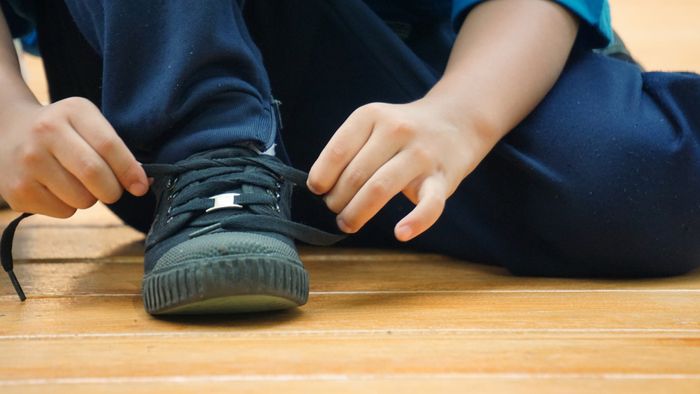Do toddler shoes come in half sizes? The answer is: it depends. Some brands do offer half sizes in toddler shoes, while others only offer whole sizes. This variability can make toddler shoe sizing tricky. This comprehensive guide will navigate the world of toddler shoe fit, helping you find the best fitting toddler shoes for your little one, regardless of whether half size toddler shoes are an option.

Image Source: entail-assets.com
The Landscape of Toddler Shoe Sizing
Toddler shoe sizing can feel like a constant guessing game. Your child’s feet are growing rapidly, and finding the right toddler shoe size is essential for their comfort and development. Shoe sizes aren’t standardized across all brands, adding another layer of complexity. One brand’s size 6 might be another’s size 6.5 or even 7!
Whole Sizes vs. Half Sizes: What’s Available?
Not all brands offer half size toddler shoes. Many shoe companies produce only whole sizes in their toddler lines. This is often due to manufacturing costs and the perception that small variations in size won’t significantly impact the toddler shoe fit. However, a half size can make a big difference in ensuring a comfortable toddler shoe experience, especially for children with wide or narrow feet.
Why Accurate Sizing Matters
Ill-fitting shoes can lead to a host of problems for toddlers, including:
- Blisters and Calluses: Shoes that are too tight can rub and cause painful blisters and calluses.
- Ingrown Toenails: Pressure from shoes that are too small can lead to ingrown toenails.
- Hammertoes and Bunions: Over time, consistently wearing poorly fitting shoes can contribute to foot deformities.
- Difficulty Walking and Running: Shoes that are too big or too small can make it difficult for toddlers to move comfortably and confidently.
- Impact on Development: Proper foot development is crucial for overall motor skills. Shoes that restrict movement can hinder this development.
Fathoming Toddler Shoe Sizes
The toddler shoe size range typically starts around size 4 and goes up to size 13. After that, children usually transition to youth sizes. Knowing where your child falls on a toddler shoe size chart is the first step in finding the right toddler shoe size.
Decoding the Toddler Shoe Size Chart
A toddler shoe size chart is a valuable tool, but it’s not foolproof. These charts typically correlate foot length (in inches or centimeters) with shoe size. It’s important to measure your child’s feet accurately and consult the specific size chart provided by the toddler shoe store or brand you’re considering.
How to Measure Your Toddler’s Feet for Shoes
Measuring toddler feet for shoes is crucial for getting an accurate size. Follow these steps:
- Gather Your Supplies: You’ll need a piece of paper, a pencil, a ruler or measuring tape, and a flat surface.
- Prepare Your Child: Have your child stand with their heel against a wall on the piece of paper. Make sure they are standing straight with their weight evenly distributed.
- Trace Their Feet: Carefully trace around both feet. It’s best to wear socks they would normally wear with shoes.
- Measure the Tracings: Use the ruler or measuring tape to measure the length of each tracing from the heel to the longest toe.
- Determine the Size: Compare the measurements to a toddler shoe size chart to find the corresponding shoe size. Always measure both feet, as one foot may be slightly larger than the other. Use the larger measurement to determine the correct size.
Considerations When Using a Toddler Shoe Size Chart
- Brand Variation: Remember that shoe sizes can vary between brands. Always consult the specific size chart for the brand you’re considering.
- Time of Day: Feet tend to swell slightly throughout the day, so it’s best to measure your child’s feet in the afternoon or evening for the most accurate reading.
- Growth Spurt: Toddlers’ feet grow quickly! Measure their feet every few months to ensure they’re wearing the correct size.
Navigating the Lack of Half Sizes
What if the brand you love doesn’t offer half size toddler shoes, or your child’s measurement falls squarely between two sizes? Here are some strategies:
Sizing Up
In most cases, it’s better to size up rather than down. Shoes that are too small can be uncomfortable and potentially harmful to your child’s feet.
- The Thumb’s Width Test: When your child is wearing the shoes, there should be about a thumb’s width of space between the end of their longest toe and the end of the shoe. This allows room for growth and prevents the toes from being cramped.
Accommodating Width
Toddler shoe width is just as important as length. If your child has wide feet, look for brands that offer wide-width shoes. If only standard widths are available, sizing up may provide extra room in the width.
- Adjustable Closures: Shoes with adjustable closures, such as Velcro straps or laces, can help provide a more secure and comfortable fit, even if the shoe is slightly larger than ideal.
Sock Thickness
Sock thickness can impact the fit of shoes. If you’re sizing up, consider using thicker socks to help fill the extra space. Conversely, if the shoes are snug, opt for thinner socks.
Inserts
Shoe inserts can be used to improve the fit of shoes that are slightly too large. Look for inserts specifically designed for children’s shoes.
Features to Look for in Comfortable Toddler Shoes
Beyond size, several features contribute to a comfortable and supportive shoe:
- Flexibility: Shoes should be flexible enough to allow for natural foot movement.
- Breathability: Look for shoes made from breathable materials, such as leather or mesh, to prevent overheating and sweating.
- Support: Shoes should provide adequate arch support and ankle support.
- Lightweight: Heavy shoes can be tiring for toddlers to wear. Choose lightweight options.
- Durable Construction: Toddlers are tough on shoes! Look for shoes that are well-made and can withstand wear and tear.
- Easy On and Off: Shoes that are easy for your child to put on and take off can encourage independence.
Where to Buy Toddler Shoes
You can find toddler shoes at a variety of retailers:
- Specialty Shoe Stores: These stores often have knowledgeable staff who can help you find the right fit.
- Department Stores: Department stores typically offer a wide selection of brands and styles.
- Online Retailers: Shopping online can be convenient, but it’s important to read reviews and check the retailer’s return policy before making a purchase. Visit toddler shoe store near you for the best shopping experience.
The Importance of Trying on Shoes
Whenever possible, have your child try on shoes before you buy them. This is the best way to ensure a comfortable and accurate fit. If you’re shopping online, make sure the retailer has a flexible return policy so you can return the shoes if they don’t fit.
Tips for Trying on Shoes
- Go Later in the Day: As mentioned earlier, feet tend to swell throughout the day, so it’s best to try on shoes in the afternoon or evening.
- Wear Socks: Have your child wear the socks they would normally wear with shoes.
- Walk Around: Have your child walk around in the shoes to see how they feel.
- Check for Slipping: Make sure the heel doesn’t slip out of the shoe when your child walks.
- Ask for Help: Don’t hesitate to ask a store employee for assistance with sizing and fit.
Getting the Best Fitting Toddler Shoes
Finding the right toddler shoe size doesn’t have to be a frustrating experience. By measuring your child’s feet accurately, consulting toddler shoe size charts, and considering width and other features, you can find comfortable toddler shoes that support their healthy development. Remember that while some brands offer half size toddler shoes, adapting to whole sizes with socks or inserts is a viable solution when half sizes aren’t available.
Fathoming Toddler Shoe Fit Over Time
Toddlers’ feet grow quickly, so it’s important to check the fit of their shoes regularly.
- Regular Checks: Check the fit every 1-2 months, or more frequently if you notice your child complaining about their shoes.
- Signs of Outgrowing: Look for signs that your child’s shoes are too small, such as redness, blisters, or pressure marks on their feet.
- Toe Cramping: If your child’s toes are cramped or curled inside the shoe, it’s time for a new pair.
FAQs About Toddler Shoe Sizing
-
What is the best way to measure my toddler’s feet?
- Use a piece of paper, a pencil, and a ruler or measuring tape. Have your child stand with their heel against a wall and trace their feet. Measure the length of each tracing from the heel to the longest toe.
-
Can I rely solely on a toddler shoe size chart?
-
A toddler shoe size chart is a helpful guide, but it’s not foolproof. Shoe sizes can vary between brands, so always consult the specific size chart for the brand you’re considering.
-
Who offers half sizes in toddler shoes?
-
Whether half size toddler shoes are available depends on the brand. Some brands offer half sizes, while others only offer whole sizes. Check with the specific brand to see if they offer half sizes in their toddler line.
-
What if my child’s shoe size falls between two sizes?
-
It’s usually best to size up rather than down. You can use thicker socks or shoe inserts to help fill the extra space.
-
Are expensive toddler shoes always better?
-
Not necessarily. While some expensive shoes may be made with higher-quality materials, the most important thing is to find shoes that fit well and provide adequate support.
-
What is the best type of closure for toddler shoes?
-
The best type of closure depends on your child’s age and dexterity. Velcro straps are easy for young toddlers to manage, while laces provide a more secure fit for older toddlers.
-
How often should I replace my toddler’s shoes?
-
Replace your toddler’s shoes every 3-6 months, or more frequently if you notice they are outgrowing them.
-
Can I hand down toddler shoes to younger siblings?
-
It’s generally not recommended to hand down toddler shoes, as they may have molded to the previous child’s foot. This can lead to discomfort and potential foot problems for the younger child.
-
What are some common mistakes parents make when buying toddler shoes?
-
Common mistakes include not measuring their child’s feet regularly, buying shoes that are too small, and not considering width.
- What is the difference between toddler and kids shoe sizes?
- Toddler sizes usually range from 4T to 13T. Once a child outgrows size 13T, they typically transition to youth or kids’ sizes, starting around size 1Y. There can be some overlap in sizing between the two categories, so it’s always best to measure the child’s foot to ensure a proper fit.
By keeping these tips in mind, you can confidently navigate the world of toddler shoe sizing and find the best fitting toddler shoes for your little one, ensuring their comfort and healthy development every step of the way.

Clark Lubowitz is a parenting expert with over 10 years of experience in toddler care and child development. Holding a degree in Early Childhood Education, he specializes in blending modern technology with parenting, offering expert advice on the best toddler gadgets. Through his work on ToddlerAwesome.com, Clark provides valuable insights to help parents make informed decisions for their little ones.
